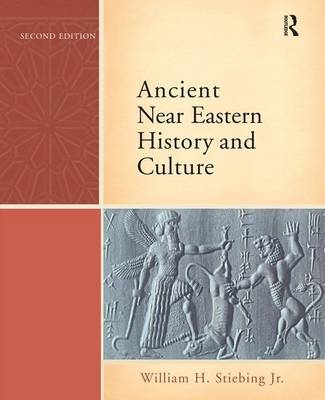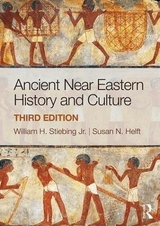
Ancient Near Eastern History and Culture
Routledge (Verlag)
978-0-321-42297-2 (ISBN)
- Titel erscheint in neuer Auflage
- Artikel merken
Organized by the periods, kingdoms, and empires generally used in Near Eastern political history, the book interlaces social and cultural history with the political narrative. This combination allows readers to get a rounded introduction to the subject of Ancient Near Eastern history.
William H. Stiebing Jr. is Porfessor Emeritus of Ancient History at the University of New Orleans.
List of Tables, Figures, Maps, and Documents
Preface
Acknowledgments
CHAPTER 1
Introduction
Studying the Ancient Near East
What Is the “Near East”?
The Nature of Historical Study
Antiquity’s “Clues”
Creating a Chronology for the Ancient Near East
A Note on Chronological Terminology: b.c.e./c.e. vs. b.c./a.d.
Absolute and Relative Chronology
Sources for Ancient Near Eastern Chronology
Prelude: Near Eastern Prehistory
The Origins of Sedentary Life (c. 10,500–8300 b.c.e.)
Early Agricultural Communities in Southwest Asia (c. 8300–6000 b.c.e.)
The Development of Complex Societies in Southwest Asia (c. 6000–3700 b.c.e.)
Early Cultures of the Nile Valley (c. 8000–3500 b.c.e.)
Debating the Evidence: The Emergence of Social Stratification and Male Dominance
CHAPTER 2
The Dawn of Civilization in Western Asia
The Emergence of Mesopotamian Civilization (c. 3700–3000 b.c.e.)
The Urban Revolution
The Development of Cuneiform Writing
Debating the Evidence: The Origin of the Sumerians
Other People of Mesopotamia
The Emergence of Elam
The Mesopotamian Early Dynastic Period (c. 3000–2330 b.c.e.)
An Era of Independent City States
Debating the Evidence: The “Royal Tombs” of Ur
Mesopotamian Culture During the Early Dynastic Era
Religion and World View
Debating the Evidence: The Sacred Marriage Ceremony
The Development of Kingship
Economy and Society
Education, Literature, and the Arts
Science, Technology, and Warfare
Urbanization in Other Areas of Western Asia (c. 3300–2300 b.c.e.)
Early Bronze Age Syria and Palestine
Early Bronze Age Anatolia and Iran
CHAPTER 3
The First Mesopotamian Empires
The Akkadian Empire (c. 2334–2193 b.c.e.) 65
Sargon of Akkad (c. 2334–2279 b.c.e)
Sargon’s Successors
Debating the Evidence: Divine Kingship
Administration of the Empire
Debating the Evidence: Reasons for Empire’s Collapse
The Third Dynasty of Ur (c. 2112–2004 b.c.e.)
Ur’s Rise to Power
Shulgi’s Reforms
The Fall of Ur
Persian Gulf and Central Asian Civilizations
Dilmun, Magan, and Meluhha
The Oxus Civilization
CHAPTER 4
The Old Babylonian Period and Its Aftermath
The “Interregnum” After the Fall of Ur (2000-1800 B.C.E.)
The Assyrian Merchant Colony at Kanesh
The Ascendancy of Isin and Larsa
Hammurabi and His Dynasty (c. 1800-1595 B.C.E.)
Shamshi-Adad’s Empire
Hammurabi and His Successors
Old Babylonian Cultural Developments
Literature
Debating the Evidence: The “Code” of Hammurabi
Babylonian Society in the “Code”
The Hittite Old Kingdom
Debating the Evidence: Indo-European Origins
The Emergence of a Hittite State
The Emergence of New Peoples
The Hurrians and the Kingdom of Mitanni
Kassite Rule in Babylonia
CHAPTER 5
EGYPT TO THE END OF THE OLD KINGDOM
The Late Predynastic Era (c. 3500–3000 b.c.e)
The Geography of Egypt and Nubia
The People of the Nile Valley
Prelude to Civilization: The Naqada II Period
The Formation of the Egyptian State (c. 3050–2686 b.c.e.)
Debating the Evidence: The Process of Unification
The Development of Egyptian Writing
The Early Dynastic Period (Dynasties 1 and 2)
Major Elements of Egyptian Culture
Ma’at
Divine Kingship
Burial and the Afterlife
Religion and Ritual
The Old Kingdom (Dynasties 3–6, c. 2686–2180 b.c.e.)
Djoser and the First Pyramid
The Zenith of Royal Power: The Fourth Dynasty (c. 2613–2498 b.c.e.)
Debating the Evidence: Dating the Great Sphinx
The Latter Part of the Old Kingdom: Dynasties 5 and 6 (c. 2498–2180 b.c.e.)
Early Egyptian Society and Culture
CHAPTER 6
The Rise And Fall Of The Egyptian Middle Kingdom
The First Intermediate Period: Dynasties 7–11a (c. 2180–2040 b.c.e.)
Where is Ma`at? 139
The Intermediate Period’s Effects
The Middle Kingdom: Dynasties 11b–13a (c. 2040–1720 b.c.e.)
The Establishment of the Middle Kingdom
The Impressive Twelfth Dynasty
Cultural Developments During the Middle Kingdom
The Second Intermediate Period: Dynasties 13b–17 (c. 1720–1540 b.c.e.)
The Onset of the Second Intermediate Period
The Kingdom of Kush (Upper Nubia)
Hyksos Rule and the Dynasty at Thebes: Dynasties 15 and 17 (c. 1650–1540 b.c.e.)
Debating the Evidence: Hyksos Relations with the Levant
Egyptian and Levantine Contacts with the Minoan Culture of Crete
CHAPTER 7
EGYPT’S POWERFUL EIGHTEENTH DYNASTY
The Beginning of the Egyptian New Kingdom (c. 1550–1479 b.c.e.) 162
The Early Eighteenth Dynasty
Debating the Evidence: The “Royal Heiress” Theory
Hatshepsut and Thutmose III (c. 1479–1425 b.c.e.)
Hatshepsut Becomes King
The Sole Rule of Thutmose III
The Egyptian Empire at Its Height (c. 1425–1350 b.c.e.)
The Reigns of Amenhotep II and Thutmose IV
Amenhotep III, “The Magnificent”
The New Egyptian Army
Late Bronze Age Canaan (Palestine and Coastal Syria)
Relations with the Aegean Kingdoms
Akhenaton and the Amarna Period (c. 1350–1334 b.c.e.)
Controversies of the Amarna Age
Debating the Evidence: Did Akhenaton Have a Co-Regency With His Father?
The Beginning of Amenhotep IV’s Reign
Debating the Evidence: Akhenaton’s Religion
Debating the Evidence: The Revolution’s Denouement
The End of the Eighteenth Dynasty (c. 1334–1293 b.c.e.)
Tutankhamun and the Restoration of Amun
The Reigns of Ay and Horemheb, (c. 1325–1293 b.c.e.)
CHAPTER 8
The End of the Bronze Age
The Zenith of Hittite Power (c. 1344–1180 b.c.e.)
Revival and Extension of the Hittite Empire
Hatti’s Showdown With Egypt
Debating the Evidence: The Historicity of the Trojan War
Hittite Culture
Economy, Society, and Government
Religion
Languages and Literature
The Twilight of the Egyptian Empire (c.1293–1150 b.c.e.)
The Empire’s Final Flash of Greatness
Invasions of the Sea Peoples
The Collapse of Bronze Age Societies in the Eastern Mediterranean
The Mycenaean Kingdoms
The Demise of the Hittite Empire
The End of Egyptian Power
The Decline of Assyria and Babylonia
Debating the Evidence: What Caused the Collapse?
CHAPTER 9
Recovery And Transformation (c. 1100–745 b.C.E.)
Mesopotamia and Egypt
Assyria and Babylonia
The Third Intermediate Period in Egypt
Anatolia
The Kingdom of Urartu
The Phrygian and Neo-Hittite Kingdoms
Syria
The Aramaeans
The Phoenicians
Debating the Evidence: Infant Sacrifice
Early Israel
Debating the Evidence: The Emergence of Israel
The Formation of the Israelite State (The United Monarchy)
The Kingdoms of Israel and Judah
Other Small States of the Southern Levant
The Philistines
Ammon, Moab, and Edom
Small Kingdoms and Confederations in Arabia
CHAPTER 10
MESOPOTAMian Supremacy
The Height of Assyrian Dominion (744–627 b.c.e.)
Reestablishment and Expansion of Assyrian Power (744–681 b.c.e.)
The Empire at Its Zenith (680–627 b.c.e.)
Neo-Assyrian Society and Culture
The King, Crown Prince, and Queen
Non-Royal Social Classes
The Army
Administration of the Empire
Art, Literature, and Science
The Neo-Babylonian (or Chaldean) Empire (625–560 b.c.e.)
Destruction of Assyria (627–605 b.c.e.)
Formation of the Neo-Babylonian and Median Empires
The End of the Neo-Babylonian Empire
Neo-Babylonian Culture
Nebuchadnezzar’s Babylon
Commerce and Finance
Scholarly Activity
Debating the Evidence: The Emergence of Biblical Monotheism
The Triumph of the Reform Movement
Developments during the Babylonian Exile
CHAPTER 11
The Achaemenid Persian Empire
The Origins and Growth of the Achaemenid Empire
The Fluorescence of the Lydian Kingdom (c. 685–547 b.c.e.)
The Creation of the Persian Empire
The Persian Empire at Its Height
Crisis and Restoration
Reorganization of the Empire
Wars With the Greeks
Persian Culture
The King and Court
The Persian Army
The Religion of Zoroaster
Persian Architecture and Art
Judah During the Persian Period
The Restoration of Judah
Debating the Evidence: The Careers of Ezra and Nehemiah
Religious Developments During the Persian Era
The Latter Part of the Achaemenid Persian Empire
The Continuation of Royal Power (424–330 b.c.e.)
Conquest by Alexander the Great
CHAPTER 12
The Legacy Of The Ancient Near East
Food, Drink, and Animals
Mathematics and Science
Language and Literature
Music, Art, and Architecture
Religion and Speculative Thought
Notes
Glossary
Chronological Chart
Index
Every chapter ends with Suggestions for Further Reading and Information (Internet Links and Books and Articles)
| Erscheint lt. Verlag | 9.7.2008 |
|---|---|
| Verlagsort | New York |
| Sprache | englisch |
| Maße | 203 x 238 mm |
| Gewicht | 640 g |
| Themenwelt | Geschichte ► Allgemeine Geschichte ► Vor- und Frühgeschichte |
| Geisteswissenschaften ► Geschichte ► Regional- / Ländergeschichte | |
| ISBN-10 | 0-321-42297-X / 032142297X |
| ISBN-13 | 978-0-321-42297-2 / 9780321422972 |
| Zustand | Neuware |
| Informationen gemäß Produktsicherheitsverordnung (GPSR) | |
| Haben Sie eine Frage zum Produkt? |
aus dem Bereich



